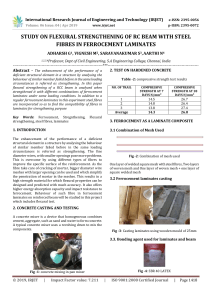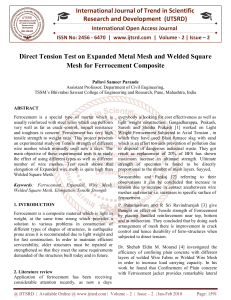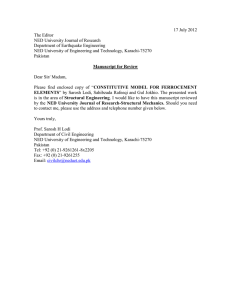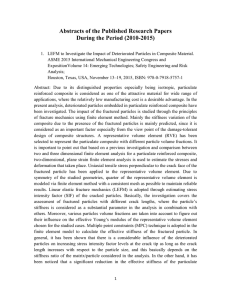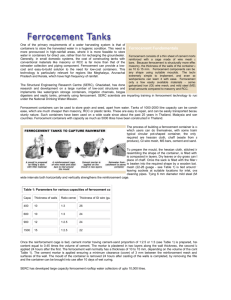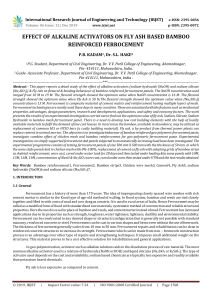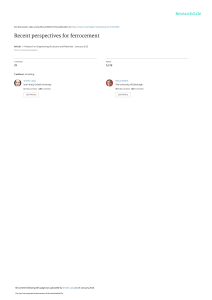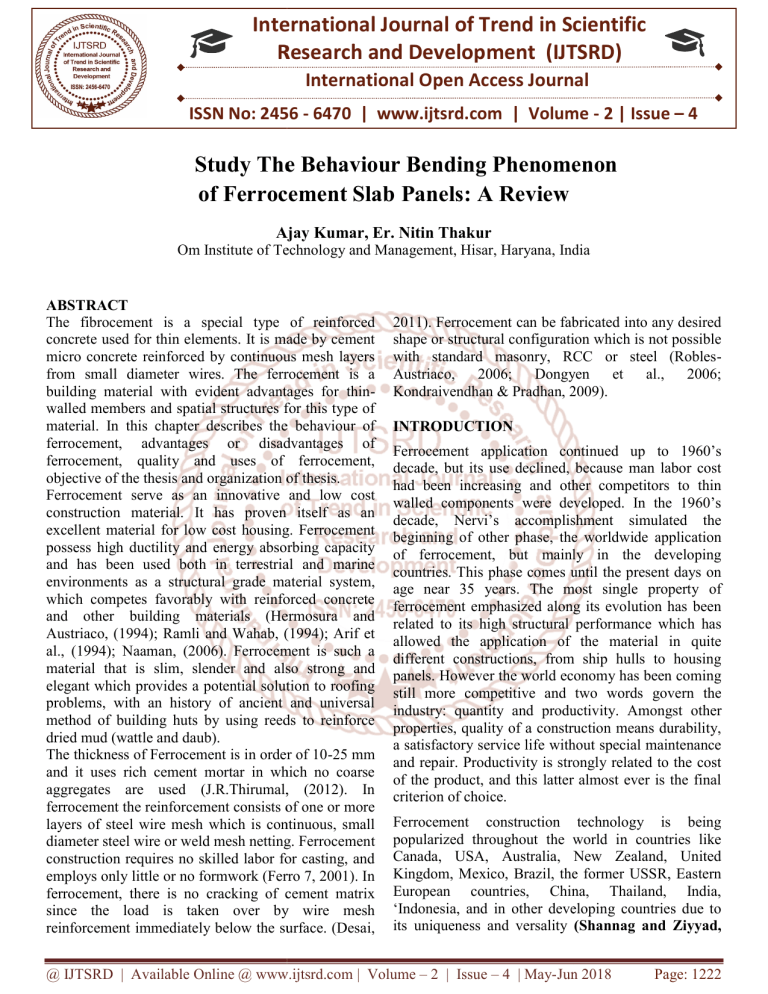
International Journal of Trend in Scientific Research and Development (IJTSRD) International Open Access Journal ISSN No: 2456 - 6470 | www.ijtsrd.com | Volume - 2 | Issue – 4 Study Thee Behaviour Bending Phenomenon of Ferrocement Slab Panels Panels: A Review Ajay Kumar Kumar, Er. Nitin Thakur Om Institute off Technology and Management, Hisar, Haryana,, India ABSTRACT The fibrocement is a special type of reinforced concrete used for thin elements. It is made by cement micro concrete reinforced by continuous mesh layers from small diameter wires. The ferrocement is a building material with evident advantages for thin thinwalled members and spatial structures for this type of material. In this chapter describes the behaviour of ferrocement, advantages or disadvantages of ferrocement, quality and uses of ferrocement, objective of the thesis and organization of thesis. Ferrocement serve as an innovative and low cost construction material. It has proven itself as an excellent material for low cost housing. Ferrocement possess high ductility and energy absorbing capacity and has been used both in terrestrial and marine environments as a structurall grade material system, which competes favorably with reinforced concrete and other building materials (Hermosura and Austriaco, (1994); Ramli and Wahab, (1994); Arif et al., (1994); Naaman, (2006). Ferrocement is such a material that is slim, slender and also strong and elegant which provides a potential solution to roofing problems, with an history of ancient and universal method of building huts by using reeds to reinforce dried mud (wattle and daub). The thickness of Ferrocement is in order of 10 10-25 mm and it uses rich cement mortar in which no coarse aggregates are used (J.R.Thirumal, (2012). In ferrocement the reinforcement consists of one or more layers of steel wire mesh which is continuous, small diameter steel wire or weld mesh netting. Ferrocemen Ferrocement construction requires no skilled labor for casting, and employs only little or no formwork (Ferro 7, 2001). In ferrocement, there is no cracking of cement matrix since the load is taken over by wire mesh reinforcement immediately below the surface. (Desa (Desai, 2011). Ferrocement can be fabricated into any desired shape or structural configuration which is not possible with standard masonry, RCC or steel (Robles(Robles Austriaco, 2006; Dongyen et al., 2006; Kondraivendhan & Pradhan, 2009). INTRODUCTION Ferrocement application continued up to 1960’s decade, but its use declined, because man labor cost had been increasing and other competitors to thin walled components were developed. In the 1960’s decade, Nervi’s accomplishment simulated the beginning of other phase, the worldwide application of ferrocement, but mainly in the developing countries. This phase comes until the present days on age near 35 years. The most single property of ferrocement emphasized along its evolution has been related to its high structural performance which has allowed the application of the material in quite different constructions, from ship hulls to housing panels. However the world economy has been coming still more competitive and two words govern the industry: quantity and productivity. productivity Amongst other properties, quality of a construction means durability, a satisfactory service life without special maintenance and repair. Productivity is strongly related to the cost of the product, and this latter almost ever is the final criterion of choice. Ferrocement construction technology is being popularized throughout the world in countries like Canada, USA, Australia, New Zealand, United Kingdom, Mexico, Brazil, the former USSR, Eastern European countries, China, Thailand, India, ‘Indonesia, and in other developing countries due to its uniqueness and versality (Shannag and Ziyyad, @ IJTSRD | Available Online @ www.ijtsrd.com | Volume – 2 | Issue – 4 | May-Jun Jun 2018 Page: 1222 International Journal of Trend in Scientific Research and Development (IJTSRD) ISSN: 2456-6470 2007). Small ferrocement tanks of less than 18.9 m3 (5000 gal) capacity were being factory built in New Zealand (Bulletin CP-10, 1968). The elevated water tanks of 47.3 m3 (12500 gal) capacity were successfully constructed in Bangladesh in 1989 (Mansur, 1990). Ferrocement silos can hold up to capacity of 10 metric tons (22400 lb) of grain/ food stuffs, fertilizer, cement and pesticide Ferrocement is more durable than wood/ timber and cheaper than imported steel. Small capacity ferrocement bins upto 3 metric tons which are cylindrical in shape, and size of 1.20 m (3.9 ft) in diameter and prefabricated in heights of 1 m (3.28 ft) is analyzed and successfully tested in India (Sharma et al. 1979) and the results have proved that ferrocement bins are less expensive than the bins made of steel, reinforced cement concrete (RCC) or aluminium. Concrete or mortar is very strong in compression but weak in tension so use steel wire mesh to increase the tensile strength and durability of the ferrocement mortar. Fly ash and silica fume are used to fill the pores and effect on the durability of mortar mix. Different proportions of the fly ash and silica fume are used in the mortar and determine the flexural strength and compressive strength. The comprehensive understanding and detailed design method of contemporary ferrocement is provided by (Naaman, 2000). However, the rapid development in reinforcing meshes 11 and matrix design requires continuous research to characterize the new material and improve the overall performance of ferrocement. Thus far steel meshes have been the primary mesh reinforcement for ferrocement, but recently fiber reinforced plastic (FRP) meshes were introduced in ferrocement as a promising alternative to steel meshes (Al-Farabi, et al, 1993, Al-Sulaimani,1994). Compared with steel, FRP materials possess some remarkable features such as lightweight, high tensile strength and inherent corrosion resistance. However, unlike steel that has an elastic-plastic stress-strain relationship, FRP materials behave elastically up to failure, thus do not yield and lack ductility. The increment in flexural strength is 11% of ferrocement panels containing badarpur sand, flyash and 8% silica fume. In case of Ganga sand it increases by 9%. 1.4 ADVANTAGES OF FERROCEMENT Ferrocement is advantageous technology for developing countries due to following reasons: It can be molded into any desired shapes. Raw materials are readily available in most countries. The skills for ferrocement construction can be acquired easily. Heavy plant setup and machinery are not required in ferrocement construction. In case of damage, it can be repaired easily. Being labor intensive, it is relatively inexpensive in developing countries CONCLUSION Following are the conclusions which are coming from the results obtained in the experimental study. The combination of fly ash and silica fume which are used in different proportions increase the durability of mortar mix. Percentage of silica fume also increases the flexural and compressive strength of specimen as compared to the conventional mix. The increment in compressive strength is higher of ferrocement cube containing Badarpur sand, flyash and 8% silica fume compare to Ganga sand. Combination of badarpur sand using fly ash and silica fume shows greater effect for increasing the quality as comparing to river sand. LITERATURE REVIEW Flexure strength, compressive strength, ductility and durability of ferrocement have been investigated by many researchers. Study on the effect of replacement of cement by materials like flyash and silica fumes has also been done to gain equal or more strength. A large number of experimental and analytical studies dealing with ferrocement structural elements, having various shapes and sizes, subjected to different loading conditions are reported in literature. 2.2 FERROCEMENT Hussain, W (1991) [1], presented extensive data on the cracking and strength behaviour of thin ferrocement sheets of 10mm thickness in flexure. Cement replacement by 50% to 70% fly ash and inclusion of super plasticizer can produce mixes of excellent flow characteristics and adequate early strength that can further ease the construction process and enable incorporation of short discrete fibers without difficulties of Fabrication. The inclusion of fibers increases stiffness, decrease deflection and @ IJTSRD | Available Online @ www.ijtsrd.com | Volume – 2 | Issue – 4 | May-Jun 2018 Page: 1223 International Journal of Trend in Scientific Research and Development (IJTSRD) ISSN: 2456-6470 shows large ductility at failure. Small opening meshes exercise better cracking control than large opening meshes. However, incorporation of fibers in the mix modifies this pattern as large result in substantial reduction in crack spacing and crack widths compared with conventional ferrocement. For structural applications of ferrocement, deflection is a Major design limitation. Fiber ferrocement along with layers of mesh can increases stiffness of the composite and reduces deflection at all stages of loading. The measured Crack spacing and crack width can be satisfactorily predicted by the method proposed in this work. ferrocement slabs. The slab panel size was 700mm X 300mm X 25mm and 30mm. The authors conclude that: The load carrying capacity of SCC ferrocement slab panel with 0.3% fibers is larger compared to without fibers, delayed the first crack load, yield load and ultimate load compared to without. There is an increase in strength with the increase of slab thickness. Hybrid reinforced ferrocement specimens could sustain the larger deflections both at yield and ultimate loads compared to the SCC ferrocement specimens. Ohama et al., (1992) [2], compared the durability of Many micro cracks are formed before failure of polymer-ferrocement with conventional ferrocement. the specimens, indicating more energy absorption The polymer-ferrocement, using styrene- butadiene and ductility. The stiffness of the specimens with rubber Latex, is prepared with various polymer2-layers bundled weld mesh is lower than that of cement ratios, and tested for accelerated carbonation, the specimens with 3 layers bundled. chloride ion penetration and accelerated corrosion. It is concluded that the carbonation and chloride ion Dr. S.K. Kaushik (1997) [4], investigated the penetration depth of polymer-ferrocement decreases behavior of eight simply supported concrete steel and markedly with an increase in polymer-cement ratio concrete ferrocement composite slabs of span 1.5m regardless of exposure and immersion periods, and are and 3.0 the strongly affected by polymer-cement ratio and waterratio and water cement ratio. The corrosion inhibiting FUTURE SCOPE property of polymer-ferrocement is remarkably Use different size and opening size of steel mesh. improved with an increase in polymer-cement ratio. As in the case of conventional reinforced concrete, the Superplasticiser can be adding for reducing the w/c ratio. mechanical properties of Ferrocement depend to a large extent on the properties of the cementitious Other pozzolonic materials can be used instead of matrix and the reinforcing steel. The apparent tensile fly ash and silica fume. properties of ferrocement represent a significant departure from that of ordinary reinforced concrete in that the dispersed reinforcement changes the observed REFERENCES cracking pattern. 1) Boshra Aboul-Anen, Ahmed El-Shafey, and S. Deepa Shri et al., (1995) [3], performed an Mostafa El-Shami, “Experimental and analytical experimental work on ferrocement panels for studying model of Ferrocement slabs”, International journal their flexural behaviour by using polypropylene of recent trends in engineering, vol. 1, no. 6, (May fibers. Silica fume is added to reduce the dosage of 2009). chemical admixtures needed to get required slump. It is well known that addition of fibers will generally 2) Dr.C.Rama Chandrudu, Dr.V.Bhaskar Desai, “Influence of flyash on flexural strength of improve the ductility, toughness, flexural strength and ferrocement in chemical environment”, vol 2, reduce the deflection of cementitious materials. In the (2012), pp. 324-329. present study, a polypropylene fiber is added to the matrix and the dosage of fibers is taken as 0.3% by 3) Dr.M. A. Mashrei, Gh. M. Kamil, H. M. Oleiwi, weight of cementitious materials. Weld mesh is “High performance of silica fume mortars for arranged in different layers in ferrocement slab ferrocement applications”, (eng. & tech. Journal, instead of reinforcement. Weld mesh of size 590 mm vol.31, part (a), no.13, (2013). X 290 mm with grid size 20 mm X 20 mm and 1.2 mm dia. Skeleton reinforcement is used for casting of 4) IS: 383-1970: Specification for Coarse and Fine Aggregates from Natural Sources for Concrete, Bureau of Indian Standard, New Delhi-1970. @ IJTSRD | Available Online @ www.ijtsrd.com | Volume – 2 | Issue – 4 | May-Jun 2018 Page: 1224 International Journal of Trend in Scientific Research and Development (IJTSRD) ISSN: 2456-6470 5) IS: 8112-1989 (Reaffirmed 2005): Specification for 43 Grade Ordinary Portland cement, Bureau of Indian Standard, New Delhi (2005). 6) Jain D. and Kothari , “ Hair Fiber Reinforced Concrete”, Research Journal of Recent Sciences, vol1, (2012), pp. 128-132. 7) Jalala. Saeed, Payman H. Mohammad , Lbrahim H. Aziz, “Behavior and flexural strength of ferrocement one way slabs with square openings”, Journal of zankoy sulaimoni (l997). 8) J.R.Thirumal, “The behavior of fiber reinforced Ferrocement slabs under impact is studied with mesh named G.I. steel weld mesh and a synthetic fiber named polyolefin”, International journal of biotech trends and technology, vol2 issue 5 number2, (Oct 2012). 9) K. Sasiekalaa1 and R. Malathy, “Behavior of mortar containing silica fume and fly ash used for ferrocement laminates”, jr. of industrial pollution control 28(1)(2012), pp.13-20. 10) Nadim Abushawashi, Vanissorn Vimonsatit, “Influence of mixture, wire mesh and thickness on the flexural performance of hybrid pva fiber ferrocement panels”, vol. 3, issue9, September (2014). 11) Nagesh M. Kulkarni, D.G. Gaidhankar , “Analysis and design of ferrocement panels an experimental study”, International journal of inventive engineering and sciences , issn: 2319–9598, vol-1, issue-5, (Apr 2013). 12) Randhir J. Phalke1, Darshan G. Gaidhankar, “Flexural behaviour of ferrocement slab panels using welded square mesh by incorporating steel fibers, International journal of research in engineering and technology , (May 2012) 13) S. Deepa Shri, “An Experimental Investigation On The Flexural Behaviour Of SCC Ferrocement Slab Incorporating fibers” International Journal Of Engineering Science and Technology (IJEST), Vol.4 No.05, (May 2012). 14) Sabih Akhtar, “Improvement in durability of ferrocement using fly ash and silica fume modified mortar” vol 3, issue 6, (Sep 2014), pp. 966-989 @ IJTSRD | Available Online @ www.ijtsrd.com | Volume – 2 | Issue – 4 | May-Jun 2018 Page: 1225
